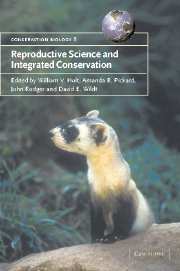Book contents
- Frontmatter
- Contents
- List of contributors
- Foreword
- Part I Introduction
- Part II Reproduction and population viability
- 2 Behaviour and reproduction
- 3 Nutrition and its interaction with reproductive processes
- 4 Environmental chemicals and the threat to male fertility in mammals: evidence and perspective
- 5 Assessing the consequences of inbreeding for population fitness: past challenges and future prospects
- 6 Impacts of inbreeding on components of reproductive success
- 7 The major histocompatibility complex (MHC) in declining populations: an example of adaptive variation
- 8 When is the birth rate the key factor associated with population dynamics?
- Part III Reproductive techniques for conservation management
- Part IV Integrated conservation management
- Part V Reproduction science in non-mammalian species
- Part VI Conclusions
- Index
- References
3 - Nutrition and its interaction with reproductive processes
Published online by Cambridge University Press: 21 January 2010
- Frontmatter
- Contents
- List of contributors
- Foreword
- Part I Introduction
- Part II Reproduction and population viability
- 2 Behaviour and reproduction
- 3 Nutrition and its interaction with reproductive processes
- 4 Environmental chemicals and the threat to male fertility in mammals: evidence and perspective
- 5 Assessing the consequences of inbreeding for population fitness: past challenges and future prospects
- 6 Impacts of inbreeding on components of reproductive success
- 7 The major histocompatibility complex (MHC) in declining populations: an example of adaptive variation
- 8 When is the birth rate the key factor associated with population dynamics?
- Part III Reproductive techniques for conservation management
- Part IV Integrated conservation management
- Part V Reproduction science in non-mammalian species
- Part VI Conclusions
- Index
- References
Summary
INTRODUCTION AND OBJECTIVES
Reproductive capabilities of mammals, birds and reptiles are influenced by nutrient provision at crucial stages of their life cycles. Nutrition of an individual inevitably depends also on that of its mother, irrespective of whether young are derived from egg-laying (birds, reptiles and prototherian mammals) or other (eutherian and marsupial) species. The maternal contribution is already pre-packaged as vitellus (yolk) at the time of oviposition in egg-laying species, and remains the sole nutrient source until post-hatch feeding commences. In contrast, most mammals rely on real-time maternally-derived nutrients throughout pregnancy and lactation.
Relative to maternal size, total nutrient requirements for production of mammalian offspring up to weaning are highly variable and exhibit enormous interspecies differences in relative distribution between pregnancy and lactation. An example is the kangaroo's trivial investment in pregnancy compared with the guinea pig's significant burden. Even within species, most notably those that produce litters, nutritional and genetic effects on numbers of ova shed and embryos surviving lead to major differences in maternal reproductive effort. It is against this background that we seek to identify feeding strategies which could enhance reproductive performance in endangered species. Central to this goal is greater understanding of specific nutrient roles in stimulating the expression of metabolic pathways that ensure reproductive success. In some cases the response to nutrition is immediate, operating directly upon target organs such as the ovary; in others full expression of nutritional effects is indirect and may not be manifest for months.
- Type
- Chapter
- Information
- Reproductive Science and Integrated Conservation , pp. 42 - 56Publisher: Cambridge University PressPrint publication year: 2002
References
- 2
- Cited by



